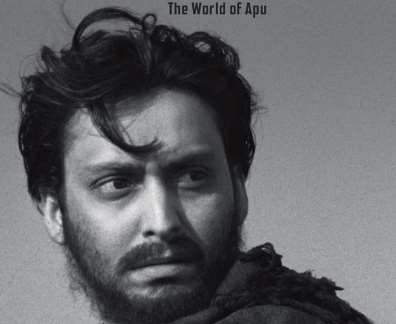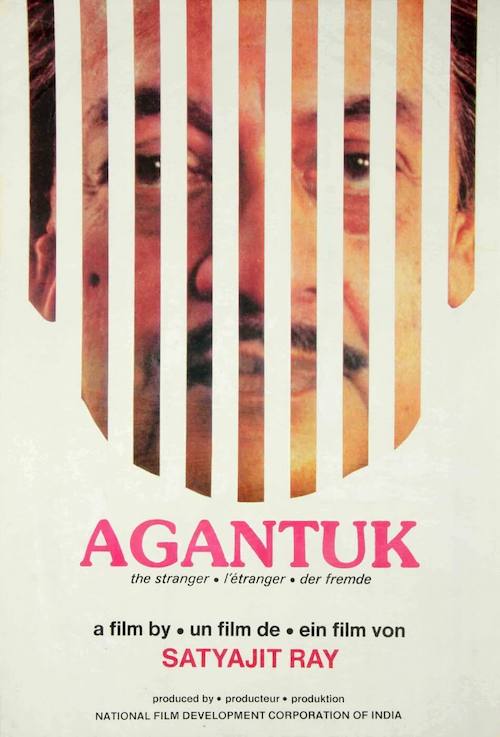In Search of a Gestalt in Ray’s cinema
Published @ Critical Collective
To view the published version, see
PDF

Satyajit Ray’s colossal presence in Indian cinema is in no need of commendation. His centenary is expected to further illuminate Ray as a storyteller, author, graphic-artist, publicist and illustrator. Despite sporadic efforts, the different manifestations of Ray’s work have so far been seen in segregation, refusing as it were, to probe into an omniscient meta-narrative that could have, undetected, informed his harvest. Are we only to contend then, with the different faces of a polygonal genius? Or is there in Ray something that can be called an intellectual equivalent of a gestalt?
Ray, indifferent to the output of the studio-era in India, was beholden instead, to European Neo-Realism as much as he was a keen observer of Hollywood. Altogether, he had developed a layered idea of the visual, to which he was nudged further in Santiniketan, as much as he was nurtured by the cosmopolitan vanguardism of his larger family of talents. When he brought his multiple influences together in Panther Panchali, (1955), it caused havoc. As film scholar Moinak Biswas notes: “A great density and beauty of description suffuses the narrative as it moves freely between plants and animals, the human world and the natural cycle. The tapestry of sounds, colours and shapes is woven through a narrative voice which, as Apu grows up, shifts imperceptibility between outside and inside him”[i]. This liberation of imagery from the purposeful servitude to formulaic melodrama is what is said to have primarily distinguished Ray from his predecessors. This is certainly the case. But I want to point out to a concurrent drive in his cinema, something that is both obvious and yet unobserved. With the Apu Trilogy (1955, 1956, 1959) Ray seemed to have laid out a distinct programme to chronicle Bengali modernity all over again. And he wanted to do it through cinema – the anointed art of modernity. It is no surprise, hence, that in the trilogy Ray explored modernity’s original theme – the decline of the rural idyll and the coming to the city of the displaced subject. The iconic scene of the train’s entry into the undisturbed landscape and its gradual encroachment in Apu’s life though the trilogy symbolized the inevitable intrusion of modernity.
Was this then the elusive gestalt in Ray? Certainly there is a pattern in what kind of concerns drew Ray, for there is a recondite refusal to be drawn, unprepared, into the political and social upheavals unfolding around. This is why Ray never directly dealt with Partition. Instead, having broken new ground, Ray continued with his appraisal of modernity, as received within the subcontinental intellectual ecology. Jalsaghar (The Music Room 1958), Devi (The Goddess 1960), and Teen Kanya (Three Daughters 1961) and Charulata (The Lonely Wife 1963) together presented three sovereign tensions in the flight to modernity: feudalism, Hindu orthodoxy and the question of women. They were also symptomatic of Ray’s trust in the figurative value of enlightened change and meaningful progress. Kanchenjunga (1962), mirroring Jalsaghar, portrayed the twilight of the privileged, late-colonial patrician. The comic-fantasy Parash Pathar (The Philosopher’s Stone 1958) and road-movie Abhijaan (The Expedition 1962) were critiques of modernity from those displaced by its haste and hustle. It was in Mahanagar (The Big City 1964), where for the first time, as Chandak Sengoopta notes, Nehruvian certainties came under direct probing[ii]. Thereafter, The Holy Man (1965) was a comic satire of tensions that were not dissimilar to those of Devi; as much as The Coward (1965) was Charulata told in reverse, in a contemporaneous world lusty for displayable accomplishments. Ray then undertook two extended studies of exceptional individuals: a phenomenally popular star in Nayak (The Hero1966) and an astute detective in Chiriakhana (The Zoo 1967), both played by Uttam Kumar, whose capacity to transport to the screen the modernity of mid-century Bengali bhadrolok was peerless. Goopy Gyne Bagha Byne (1968) and its heir Hirak Rahar Deshe (1980) were genre-defying parables and Ray’s only indictment of the vulgarity of realpolitik. It is with Aranyer Dinratri (Days and Nights in the Forest 1969) – a riveting assessment of urban solipsism and social vanity – that Ray decidedly shifted gear, for having chronicled the arrival of modernity, he had to start accounting for its disappointments. What followed was his famed Calcutta trilogy – Pratidwandi (The Adversary 1970), Seemabaddha (Company Limited 1971) and Jana Aranya (The Middleman 1975) – which were an evocative and exigent survey of life in a distressed metropolis. In the ensuing years, Ray’s feature-length films traversed forms – two detective fictions involving Feluda, trenchant accounts of famine and caste; and a period piece. All of them were integral to his persistent project of probing modernity’s surfaces, while Ghare Baire (Home and the World 1984) – his only full-length film in the 1980s – reprised the theme of women and modernity. But mid-70s onwards, Ray’s probing was proving to be less and less effective.

In order to find a suitable closure to his grand enquiry, Ray’s ambitious project had to settle for a decisive denouement. It is with such a plan, attended by his force of conviction that he retraces his steps in his final trilogy Ganashatru (Enemy of the People 1990), Sakha Prasakha (The Branches of the Tree 1990) and Agantuk (The Stranger 1992). All three were set in the claustrophobic, self-absorbed world of the middle-class, who seemed to have waylaid the bequests of enlightenment in their blind march towards a shambolic idea of success. To make this point, Ray had simplified the moral architecture of the class he was critiquing, especially in Ganashatru and Sakha Prasakha. Even if overt in its assertion about the failures of plastic modernity, Agantuk presents a more nuanced case. But all the three films display a polarized parceling of moral positions and opinions; the settings were strongly interiorized, the characters were drawn in thick brush; and the conflict – blind faith, corruption, vanity etc – were laid out with unambiguous clarity. In short, the final tragedy were miles away from the sinewy, chiaroscuric, slippery world of the Calcutta trilogy. This simplification of the moral order, the plot and the setting into distinct binaries provoke us to think that Ray, in his sunset years, was keener to lay down the consequence of modernity within the arc of his work rather than provoke new questions. In other words, the fate of the contemporary bothered Ray less than the fate of the project of modernity. To that end, the final trilogy had the form of a fable. If one is able to comprehend Ray’s omniscient metanarrative, one will also sense Ray’s consistent reprisal of faith in the quiet heroism of the enlightened subject. From Apu to Byomkesh Bakshi (Chiriakhana), Ray hardly falters in his investment in the primacy of the sapient subject to determine the course of modernity. In fact, this primacy connects not only his films but also the fraternal wisdom of Feluda – Ray’s detective for young adults[1]; or the homegrown globalism of scientist extraordinaire Professor Shanku[2]. The onus is not only on men, because as long as Ray has not lost faith in the project of progress, women occupy an autonomous and authoritative presence (including the uncelebrated fortitude of Apu’s mother Sarbajaya) in the push towards enlightenment. But once his faith falters, Ray despondently goes back to the family of man, and holds on to three middle-aged outliers in his closing trilogy Of them, the one most conscious of the hollow foppery of the world is Manmohan in Agantuk. He is both a rootless cosmopolitan and an enigmatic guest, who returns for one last time to let know that the bell has started to toll on the idea of progress. Like Apu half a century ago, Manmohan leaves too at the end. But Apu carried his son along, indicating a restoration of his lost faith in his legacy. It is telling indeed that the maladjusted Manmohan vanishes back into the wild atomized, alone and untraceable.
[1] See Chowdhiry Sayandeb, ‘Ageless Hero, Sexless Man: A Possible Pre-History and Three Hypotheses On Satyajit Ray’s Feluda’, South Asia Review, [Satyajit Ray Special Issue]. 36.1:109-130. Routledge/Taylor & Francis. 2015. Print. ISSN 0275-9527.
[2] See Chattopadhyay, Bodhisattva. “Kalpavigyan and Imperial Technoscience: Three Nodes of an Argument.” Journal of the Fantastic in the Arts, vol. 28, no. 1 (98), 2017, pp. 102–122. JSTOR, www.jstor.org/stable/26390196. Accessed 28 Apr. 2021.
[i] Moinak Biswas ‘Early Films: The Novel and other Horizons’, Moinak Biswas (ed), 2005, Apu and After, Re-visiting Ray’s Cinema; Seagull Books, Calcutta. 37-79. p 47.
[ii] Chandak Sengoopta, ‘Satyajit Ray: Liberalism and Its Vicissitudes’, Cinéaste 34:4 (2009),
16-22, p 18
comments for this post are closed